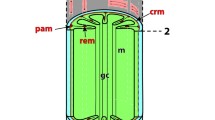Summary
The larval muscle cells of Diplosoma macdonaldi contain subcortical and medullary myofibrils which are invested by fenestrated sheets of the sarcoplasmic reticulum. Cisternae of the sarcoplasmic reticulum are coupled with tubular invaginations of the sarcolemma. To appreciate better such uncommon features of cellular organization, six embryonic stages were selected for an ultrastructural study of myogenesis. The proliferative, synthetic, and elaborative phases of myogenesis were represented by embryos ranging from neurulae to prehatching larvae.
The contractile apparatus originates during the synthetic phase of myogenesis, when thick and thin myofilaments appear in the cortical sarcoplasm at the epidermal and notochordal poles of the cell. The myofilaments promptly aggregate into unstriated fascicles, and the fascicles unite in series to establish the rudimentary myofibrils. All major sarcomeric bands, except the Z-lines, are evident along the myofibrils. Cisternae of the sarcoplasmic reticulum form peripheral couplings with the overlying sarcolemma, and they also form interior couplings with sarcolemmal invaginations from the ends of the cell. The interior couplings localize over the I-bands of the myofibrils.
In the elaborative phase of myogenesis, mitochondria invade the cortical sarcoplasm, and the contractile apparatus passively shifts to the subcortex and medulla of the cell. Relocation of the myofibrils coincides with the disappearance of all peripheral couplings. Cisternae of the sarcoplasmic reticulum anastomose around the myofibrils, creating the fenestrated sheets that extend between sarcomeres. As Z-lines begin to bisect the I-bands, the perifibrillar cisternae become confluent with the cisternae in the precocious interior couplings.
Similar content being viewed by others
References
Bone Q, Ryan KP (1975) On the presence of a transverse system in tunicate muscle. Acta Zool (Stockh) 56:271–277
Burighel P, Nunzi MG, Schiaffino S (1977) A comparative study of the organization of the sarcotubular system in ascidian muscle. J Morphol 153:205–224
Cavey MJ (1978) Differentiation of the sarcoplasmic reticulum and sarcolemmal couplings in somatic muscle cells of a larval ascidian. Am Zoologist 18:581
Cavey MJ (1982) Myogenic events in compound ascidian larvae. Am Zoologist 22:807–815
Cavey MJ, Cloney RA (1972) Fine structure and differentiation of ascidian muscle. I. Differentiated caudal musculature of Distaplia occidentalis tadpoles. J Morphol 138:349–374
Cavey MJ, Cloney RA (1974) Fine structure and differentiation of ascidian muscle. II. Morphometrics and differentiation of the caudal muscle cells of Distaplia occidentalis tadpoles. J Morphol 144:23–70
Cavey MJ, Cloney RA (1976) Ultrastructure and differentiation of ascidian muscle. I. Caudal musculature of the larva of Diplosoma macdonaldi. Cell Tissue Res 174:289–313
Ceresa Castellani L, Camatini M, Lora Lamia Donin C (1972) Aspetti ultrastrutturali della muscolatura di ascidia. Ist Lombardo (Rend Sc) B 106:59–72
Cloney RA, Florey E (1968) Ultrastructure of cephalopod chromatophore organs. Z Zellforsch 89:250–280
Fischman DA (1972) Development of striated muscle. In: Bourne GH (ed) The structure and function of muscle, vol 1. Academic Press, New York, pp 75–148
Luft JH (1961) Improvements in epoxy resin embedding methods. J Biophys Biochem Cytol 9:409–414
Reynolds ES (1963) The use of lead citrate at high pH as an electron-opaque stain in electron microscopy. J Cell Biol 17:208–212
Richardson KC, Jarett L, Finke EH (1960) Embedding in epoxy resins for ultrathin sectioning in electron microscopy. Stain Technol 35:313–323
Schiaffino S, Nunzi MG, Burighel P (1976) T system in ascidian muscle: Organization of the sarcotubular system in the caudal muscle cells of Botryllus schlosseri tadpole larvae. Tissue & Cell 8:101–110
Terakado K (1972) Cytological and ultrastructural studies on muscle differentiation in the ascidian, Perophora orientalis. Dev, Growth, Differ 14:1–23
Terakado K (1975) Fine structure and size distribution of free thick filaments in early fibrillogenesis of ascidian tadpole. Dev, Growth, Differ 17:355–365
Walker SM, Edge MB (1971) The sarcoplasmic reticulum and development of Z-lines in skeletal muscle fibers of fetal and postnatal rats. Anat Rec 169:661–678
Walker SM, Schrodt GR, Currier GJ, Turner EV (1975) Relationship of the sarcoplasmic reticulum to fibril and triadic junction development in skeletal muscle fibers of fetal monkeys and humans. J Morphol 146:97–128
Warren RH (1973) Interaction of the sarcoplasmic reticulum with Z-lines during myogenesis in amphibian skeletal muscle. Anat Rec 177:225–242
Wood RL, Luft JH (1965) The influence of buffer systems on fixation with osmium tetroxide. J Ultrastruct Res 12:22–45
Author information
Authors and Affiliations
Rights and permissions
About this article
Cite this article
Cavey, M.J. Ultrastructure and differentiation of ascidian muscle. Cell Tissue Res. 230, 77–94 (1983). https://doi.org/10.1007/BF00216029
Accepted:
Issue Date:
DOI: https://doi.org/10.1007/BF00216029




